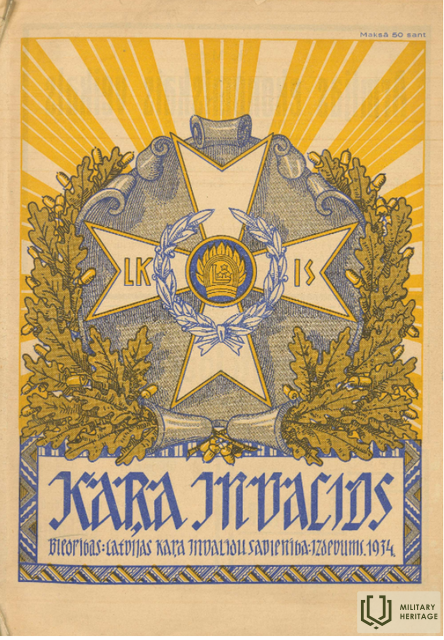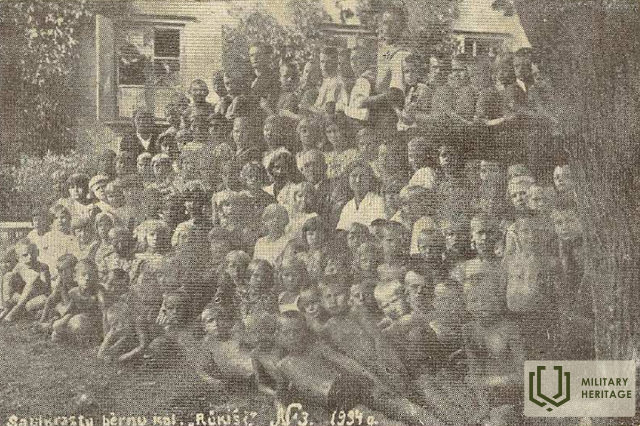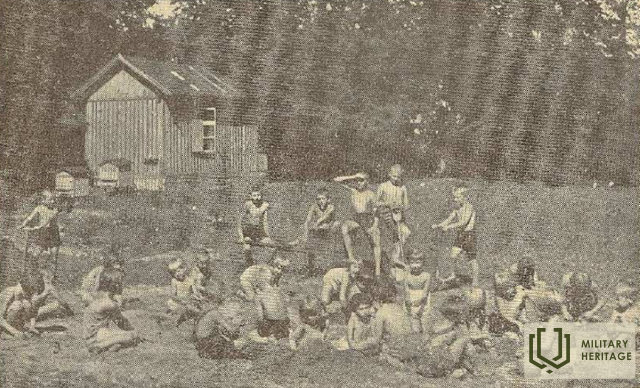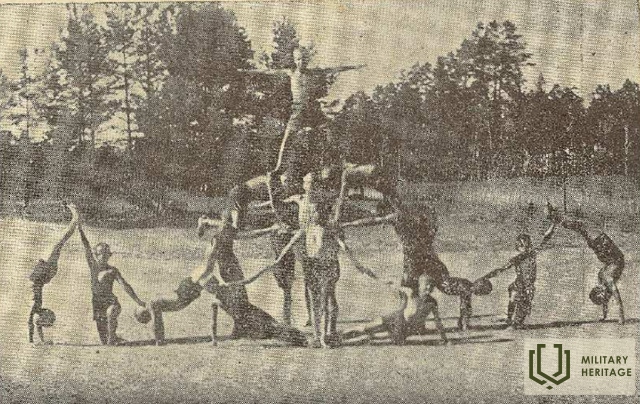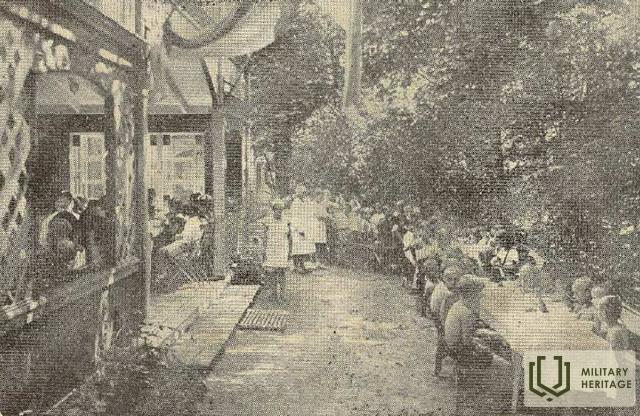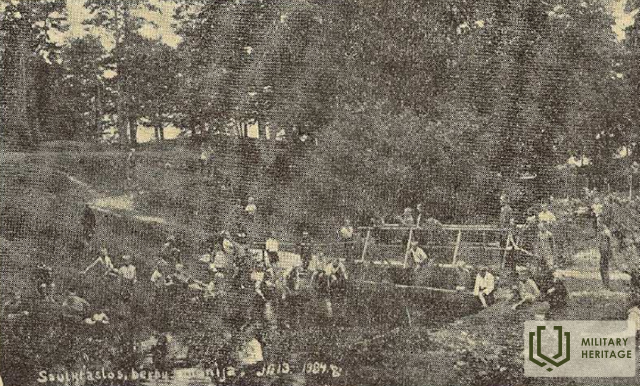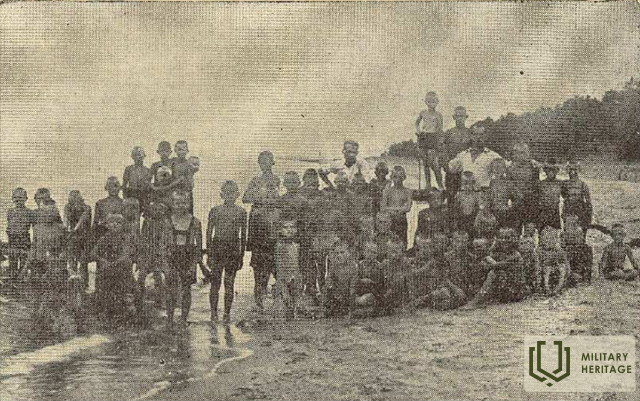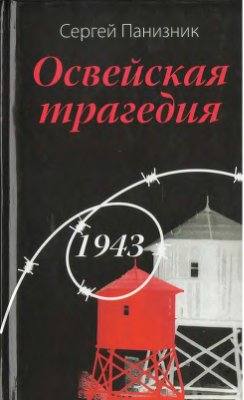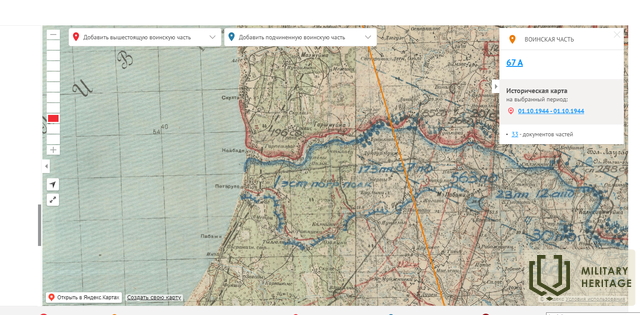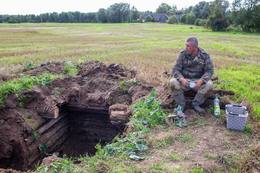Apie vaikų kolonijos „Rūkiši“ įvykius prieškario ir Antrojo pasaulinio karo metais
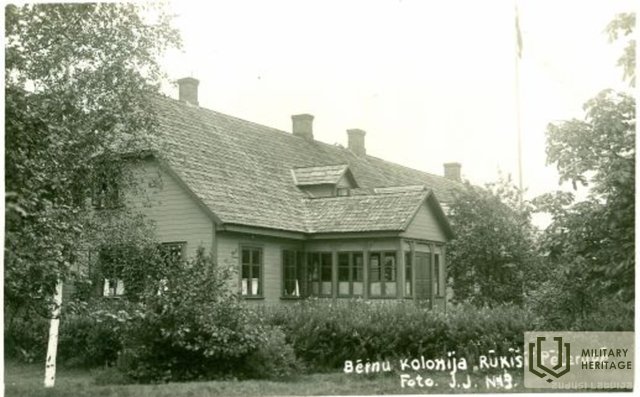
Iš partizanų rėmėjų šeimų buvo atimti vaikai. 1943 m. kovo mėn. Salaspilio lageryje buvo 1100 vaikų. Nuo tymų, vidurių šiltinės ir kitų ligų mirė apie 250 vaikų, keli šimtai vaikų buvo perkelti į aplinkinių parapijų ūkius, apie 300 vaikų atsidūrė vaikų globos namuose Jūrmaloje, Igatėje ir Saulkrastuose Rygoje.
Saulkrastuose vaikai atvyko į Latvijos pagalbos vaikams draugijos „Rūkišų“ vaikų koloniją.
Apie tai, kaip buvo įkurta Latvijos pagalbos vaikams draugijos „Rūkiši“ vaikų kolonija
1929 m. dėl mokinių trūkumo buvo uždaryta keturmetė Plādeso mokykla, kuri iki 1912 m. buvo vienintelė mokykla pajūrio žvejų kaimuose.
1930 metais pradėjo veikti Latvijos pagalbos vaikams draugijos „Rūkiši“ vaikų kolonija, kurioje apsistojo apie 110 vaikų.
"Kolonijoje vaikai gauna paruoštą maistą, patalynę, prausimąsi, medicininę pagalbą ir auklėtojų priežiūrą. Kolonijos metinis biudžetas – 13 000-15 000 Lt. Vaikų gynimo dienos metu buvo atliekami namų darbai, rūpinimasis savimi, mankšta, dainavimas, piešimas, žaidimai, vaikų užduotys, ekskursijos. priimtas į „Rūkišius“ Karo neįgaliųjų pagalbos tarybos lėšomis“. (Karo invalidas, Nr. 1 (1934 01 01))
Iš periodinių leidinių sužinota, kad „Rūkišų“ kolonijoje apsistojo ir vaikai iš Lietuvos bei Estijos: „Vaikų vasaros kolonija Saulkrastuose priims 200 vaikų. Latvijos pagalbos vaikams draugija pirmadienį atidarys vaikų vasaros koloniją „Rūkiši“ Saulkrastuose, priimdama apie 100 vaikų. Pirmoje pamainoje vaikų bus priimama tiek pat 6 savaites. ir antroji pamaina buvo gautas atsakymas iš Lietuvos, kad šią vasarą vaikai nebus siunčiami į Latviją, tačiau Estijos pagalbos vaikams sąjunga dar neatsiliepė. (Latvijos kariai, Nr. 131 (1940.06.13))
Apie įvykius „Rūkišų“ kolonijoje Antrojo pasaulinio karo metais
1982 metų „Darba balssis“ V. Strazdinės straipsnis „Atminimo sargyba“, kur Elza Gailīte dalijasi prisiminimais apie Antrojo pasaulinio karo įvykius „Rūkišiuose“:
Elzos Gailytės (86 m.) kalbėjimo stilius iš pradžių lakoniškas:
1943 metų birželį Saulkrastų „Rūkišiuose“ buvo įkurta prieglauda Salaspilio vaikams, kurių tėvai buvo įkalinti, sunaikinti ar išvežti į Vokietiją, sako ji, rankoje turinti tai patvirtinančius dokumentus. – Į Saulkrastus buvo atvežti paskutiniai išgyvenę 2-12 metų vaikai. Apie 70 vaikų, serga, pavargę, guli lovoje... Buvo niežai, utėlės, skarlatina... Penkių iš jų nepavyko išgydyti, jie mirė. Vaikus prižiūrėjo 12 žmonių. Vadovė buvo Lidija Koroliova. Pas mus vaikai pamažu atsigavo, buvo maitinami, prižiūrimi.
Gryname ore, saulėje, prie jūros... Vėliau mūsų pastogė buvo perkelta į Zimmermani namą (šeimininkas buvo repatrijuotas į Vokietiją), ant Ķīšupītės kranto. Jau 1944 m. ten buvo belaisvių stovykla.
Kaliniai mirė nuo šiltinės. Mes čia gyvenome apie pusmetį, iki 1944 09 25. Kol fašistai įsakė išsikraustyti (per pusantros valandos), eiti su kariuomene... . Nusprendėme: keltis atgal į „Rūkišius“. Mes išsiskyrėme. Keturi ar penki vaikai su savimi turėjo savo mamas. Tie, kurie išvyko, nebuvo toli nuėję. Maži, trimečiai... Batai ant kojų, šlepetės nukrenta... Pradėjo verkti. Taip visi grįžo. Visi susirinkome dideliame rūsyje. Buvo apie 80 žmonių. Susiglaudėme ir laukėme, kas bus. Viską pradėjo fašistai Susprogdinome geležinkelį, tiltą... Vieną tarną išsiuntėme atgal į Zimmermani namus produktų.
Ten mama Paukštė mums kepė duoną didelėje krosnyje.
– O gal ji buvo jūsų aptarnaujančio personalo dalis?
– Ne. Ji buvo tiesiog labai geras žmogus, padėjo mums vardan draugystės, kaip kaimynė.
Visuose darbuose. Net ir su maisto pirkimu. Prašau ją surasti: ji galės tau daug ką pasakyti. Taip, surask abu – Paukščio motiną ir Paukščiuką...
Liko tik dar vieni miltai kepimui. Jei išeisime, mirsime iš bado, samprotavome.
Antifašistinis vokietis pasakė: „Mūsiškiai ilgai neišsilaikys. Atsitraukime. Geriausia tau čia pasilikti."... Rugsėjo 25 d., vakaro penktą valandą, pas mus atėjo fronto linija. Dvi sunkios dienos ir naktys prabėgo ugnimi... Vaikų rūsyje ilgai nelaikysi. Įbėga, išeina. Ir tada bėga atgal, šaukdami: "Jūsų!" Netrukus ateis raudonarmiečiai, pasisveikinti. ginklai, prasidėjo šaudymas...
– Taip, Saulkrastą išleido spalio 11 d., – pridursiu.
– Buvo labai kruvinų mūšių...
Važiuodami pro Skultą pirmą kartą pamatėme naujas kovines mašinas „Katyusha“. Mus apgyvendino tuščiame name Limbažiuose. Miegojome ant grindų, be sienos, be nieko. Parduotuvės tuščios. Tada komendantas atsiuntė pieno, duonos. Visiems buvo po vieną puodelį. Atsiuntė mėsą ir kibirą. Virėme kibire. Buvo sunku. Bet buvo... ramybė. Bombos nebesprogo, virš galvų nebeskrido sviediniai, vaikai nusiramino, nepapuolė į isteriją, neberėkė iš siaubo dėl sužeistųjų, užmuštų žmonių, arklių, dėl visko, kas gyva. .. Limbažiuose namai buvo daugiaaukščiai. Jie mus aprūpino lovomis, drabužiais ir viskuo. Laukėme Pergalės dienos. Vaikai pradėjo laukti artimųjų. Daugelis tėvų buvo išsiųsti į Vokietiją. Jie buvo rasti tik po metų. Prieglauda gyvavo iki 1945 m. vasaros. Vaikai buvo paskirstyti po kitas vaikų įstaigas. Daug baltarusių vaikų dabar liko Latvijoje. Viena mergina instinktyviai jautė, kad sutiko mamą, bet nebemoka mamos kalbos.
– Kaip vaikai išlipo iš Salaspilio?
– Kaip rašytojas Paniznikas atrado šią „Rūkišų“ istoriją?
Rašytojo sesuo gyvendama Kauguryje. Dažnai važinėjo į Rygą ir apie tai skaitė „Rīgas Balsyje“ 1978 m. Tačiau susidomėjo, nes „Rūkišiuose“ daugiausia buvo baltarusių vaikai.
Rašytojas surado Elzą Gailīti. Vėliau įvyko apsikeitimas laiškais, daug tyrimų. Elza Gailīte knygą su autorės dedikacija jau gavo dovanų. Jis vadinamas „Po sudegusių kaimų...“. Jame yra skyrius „Saulėtų krantų nykštukai“.
Knyga apie Petrą ir Viktorą, kurie vaikystėje tarnavo šeimininkams, kiekvienas savo. O susitikę po 20 metų sužinojo: abu broliai baltarusiai, iš Rygos; vienas dabar buvo latvis, kitas rusas... .
Bet Nadežda Boguša atsiuntė padėkos laišką tuometinei „Rūkiši“ ūkio vedėjai Elzei Gailītei.
Apie šiuos įvykius Saulkrastuose nėra kam pasakoti. Net Motinos Paukščio ir Tėvo Paukščio nebėra... ten 20 metų. Sūnūs patvirtina: pašiūrė egzistavo. Wedekla Hilda apie savo anytą sako: „Ji buvo nuostabiai malonus žmogus“.
Nerekonstruotų „Rūkišų“ nuotraukos: taip pat nepavyko rasti. Ir staiga, po dvejų metų paieškų – randame savo bibliotekos istorinės medžiagos archyve, kurį rinkome šeštojo dešimtmečio antroje pusėje.
O savo sąsiuvinyje randu užrašytą filmo komentarą: "Mes stovime tarp vakar davėjo ir rytojaus davėjo. Ir jiedu negali susitikti be mūsų."
Ištyrus informaciją, išsiaiškinta, kad Elzos Gailytės prisiminimuose minima Sergejaus Panizniko knyga rusiškai vadinosi „Освейская трагедия 1943“.
Kolonija „Rūkiši“ Antrojo pasaulinio karo metais atliko vaikų globos namų funkcijas ir didžiulė padėka tiems žmonėms, kurie globojo be tėvų likusius ir karo baisumus patyrusius, atskirtus nuo tėvų ir išblaškytus po Latviją vaikus.
http://kamunikat.org/usie_knihi?pubid=44344&lang=EN
Latvijos nacionalinės bibliotekos periodiniai leidiniai, karo invalidas, Nr.1 (1934-01-01)
Latvijos nacionalinės bibliotekos periodika, Latvijas Kareivis, Nr. 131 (1940 06 13)
Latvijos nacionalinės bibliotekos periodika, 1982 "Darbo balsas" V.Strazdiņa straipsnis "Atminimo sargyba"
Inga Zemīte „Saulkrasti – nuo seniausių laikų iki Latvijos nepriklausomybės atkūrimo“, išleido Saulkrastų apskrities taryba
https://lv.wikipedia.org/wiki/Salaspils_koncentr%C4%81cijas_ometne
Susijusi laiko juosta
Susijusios vietos
WWII German army bunker
It was located near the house in "Brankša" on a grain field.
On September 2, 2021, under the guidance of Andras Grabčiks, a history enthusiast of the Saulkrasti region, and in coordination with Ines Karlova, the tenant of agricultural land, excavation works of the German army bunker of the Sigulda defense line of World War II took place.
"77 years have passed since the bunker was built, experienced both the attack of the Soviet Army and the driving of agricultural machinery over it. Only 3 years ago, it partially succumbed to the heavy machinery. To prevent the floor from being flooded, a drainage system was developed with a water storage reservoir at the entrance, which, if necessary, exhausted. The floor of the bunker is made of round logs 10 cm in diameter and was covered with straw. This bunker is not one of the big ones, but quite enough for about 6 people. This bunker is not the only one in the area, but one of the few that is well preserved." - this is what Andris Grabčiks says about the bunker.
After the information was published on the Internet, 2 scanned historical photographs were received from the historian and owner of the Saulkrasti Bicycle Museum, Jānis Seregins, with the inscription "29.08.44, Saulkrasti, Vidrižu parish" and the comment: "The photographs were obtained from a Saulkrasti resident, who is now dead. According to her story, refugees from Pskov and Leningrad region, who were driven out of their homes by the retreating Germans, had settled in Saulkrasti. They were employed in digging trenches in the defense line near Ķīšupe. One of the pictures shows people in forest works. In this way, the logs that we can see now in the bunker near Brankša were obtained. The second picture shows how they are fed at a distribution point near the house or in the kitchen. I think it's the Branch Mill."
The bunker has been preserved from WWII on the defensive line of Sigulda.
The site of the first rezi bunker was surveyed in April 2021, but due to the high ground water, excavation work could not take place.
The bunker is located on agricultural land and after excavation and exploration, it was filled in so as not to interfere with agricultural work.





